MYCORRHIZAL ASSOCIATIONS: The Web Resource
Section 8. MYCORRHIZAL ASSOCIATIONS OF AUSTRALIAN PLANTS
A. Introduction
This section summarises knowledge of mycorrhizal associations of Australian plant families and genera in the table below. This information can be used to help restore disturbed habitats and to understand interactions between plants, fungi and animals, as well as nutrient cycling in natural ecosystems. More information on nonmycorrhizal plants is provided in Section 6. Definitions used to define arbuscular mycorrhizas (VAM) and ectomycorrhizas (ECM) follow section 1. However, papers do not always state that structures which define associations were observed. Some plants were reported to be mycorrhizal in some studies, but not others. These may be facultatively mycorrhizal plants, inadequate samples, or cases where mycorrhizal definitions were not applied.
B. Mycorrhizas and Roots of Australian Plants
Table background colours separate mycorrhizal categories. Plant genera with more than one category are highlighted. Results are summarised in the following section. Generic names follow the original publications in most cases, but family names have been updated.
| Family | Species | Form | Mycorrhiza | References |
| I. FERNS & FERN ALLIES (see Section 2 also) | ||||
| Aspleniaceae | Asplenium | ferns | VAM / NM | most samples NM - Cooper 1976 (NZ), VAM & NM - Gemma et al. 1992 (Hawaii). |
| Blechnaceae | Blechnum | ferns | VAM | Cooper 1976 (NZ), Gemma et al. 1992 (Hawaii). |
| Cyatheaceae | Cyathea | tree ferns | VAM | Cooper 1976 (NZ), Gemma et al. 1992 (Hawaii). |
| Dennstaedtiaceae | Hypolepis (NZ), Pteridium | fern | VAM | Cooper 1976 (NZ), Brockhoff & Allaway 1988, Logan et al. 1989. NM - Sward 1978 |
| Dicksoniaceae | Dicksonia | tree fern | VAM | Cooper 1976 (NZ) |
| Dryopteridaceae | Polystichum, Rumohra | ferns | VAM | Cooper 1976 (NZ). |
| Gleicheniaceae | Gleichenia | ferns | VAM | Cooper 1976 (NZ). |
| Hymenophyllaceae | Hymenophyllum, Trichomanes | filmy ferns | VAM | Cooper 1976 (NZ). |
| Isoetaceae | Isoetes (submerged aquatic plants) | fern ally | VAM | Clayton & Bagyaraj 1984 (NZ). See Section 2. |
| Lindsaeaceae | Lindsaea | fern | VAM | Cooper 1976 (NZ), Gemma et al. 1992 (Hawaii), Brundrett et al. 1995. |
| Lycopodiaceae | Lycopodium, Phylloglossum | fern ally | VAM, NM | Lycopodium adult VAM Cooper 1976 (NZ), NM - Johnston & Ryan 2000. Phylloglossum Hyphal coils in gametophyte MH VAM? - Holloway 1935 (NZ). |
| Nephrolepidaceae (=Lomariopsidaceae) | Arthropteris (NZ) Nephrolepis | fern | VAM | Cooper 1976 (NZ) Nephrolepis epiphyte - Reddell et al. 1996 |
| Osmondaceae | Todea | ferns | VAM | Cooper 1976 (NZ) |
| Polypodiaceae (Grammitidaceae) | Drynaria, Grammitis, Pyrrosia | ferns | ˙VAM (NM) | Cooper 1976 (NZ). Drynaria NM on rock - Brundrett et al. 1995. |
| Psilotaceae | Tmesipteris (NZ), Psilotum | lower ferns | VAM, MH VAM |
Tmesipteris Sporophyte VAM - Copper 1976 (NZ). Psilotum soporophyte VAM - M. Brundrett (unpublished), Gemma et al. 1992 (Hawaii). See Section 2. |
| Pteridaceae (inc. Adiantaceae, Hemionitidaceae, Sinopteridaceae) | Adiantum, Cheilanthes, Pellaea, Platyzoma, Pteris | ferns | VAM (NM) | Cooper 1976 (NZ), Gemma et al. 1992 (Hawaii), Platyzoma NM - Brundrett et al. 1995. |
| Schizaeaceae | Schizaea | ferns | VAM | Copper 1976 (NZ), Gemma et al. 1992 (Hawaii), Brundrett et al. 1995 |
| Selaginellaceae | Selaginella | fern ally | NM / VAM | Sward 1978. VAM also reported - see Section 2. |
| Thelypteridaceae | Thelypteris | fern | VAM | Cooper 1976 (NZ). |
| Woodsiaceae (Athyriaceae) | Cystopteris | fern | VAM | Cooper 1976 (NZ). |
| II. GYMNOSPERMS (see Section 2 also) | ||||
| Araucariaceae | Agathis, Aracauria, Phyllocladus, Wollemia | trees | VAM | Beaded VAM roots - Baylis et al. 1963 (NZ), Bevege 1968 (7 spp.), McGee et al. 1999. Wollemia occasional ECM - McGee et al. 1999. |
| Cupressaceae | Callitris | trees | VAM | Bevege 1968,Reddell & Milnes 1992, Pattinson et al. 2004. |
| Podocarpaceae | Dacrycarpus, Dacrydium, Podocarpus, (Prumnopitys) | trees, shrub | VAM | Bevege 1968 (3 spp.), Reddell et al. 1996. NZ refs - Baylis et al. 1963, Johnson 1977, Hurst et al. 2002, Russell et al. 2002. VAM in beaded roots |
| Zamiaceae | Lepidozamia, Macrozamia (Cycads) | shrubs, trees | VAM | Brundrett & Abbott 1991, Reddell et al. 1996. These also have coralloid N2 fixing roots - Lamont 1982, Grove et al. 1980. |
| III. ANGIOSPERMS - DICOTYLEDONS | ||||
| Aizoaceae | Carpobrotus, Sesuvium, Trianthema | herbs | NM | Brockhoff & Allaway 1988, Logan et al. 1989, Brundrett et al. 1995. |
| Amaranthaceae | Alternanthera, Gomphrena, Ptilotus | herbs | NM | Reddell & Milnes 1992, Brundrett et al. 1995, O'Connor et al. 2001 |
| Anacardiaceae | Buchanania | tree | VAM | Brundrett et al. 1995 |
| Annonaceae | Melodorum, Polyalthia, Xylopia | vine, trees | VAM | Brundrett et al. 1995, Reddell et al. 1996 |
| Apiaceae (Umbelliferae) | Aciphylla, Actinotis, Eryngium, Platysace, Hydrocotyle, Lilaeopsis, Oreomyrrhis, Trachymene, Xanthosia | herbs | VAM | Johnson 1977 (NZ), Sward 1978, Clayton & Bagyaraj 1984 (NZ), Peterson et al. 1985, Brundrett & Abbott 1991, Bellgard 1991, Johnson & Ryan 2000, O'Connor et al. 2001, Warcup (1980) and Bellgard (1991) report ECM-like association in Platysace. |
| Apocynaceae (Asclepiadaceae) |
Alyxia, Cynanchum, Ichnocarpus, Wrightia | herb, shrub, vine, trees | VAM | Koske 1992, Brundrett et al. 1995, Reddell et al. 1996, Gehring & Connell 2006. |
| Apodanthaceae (Rafflesiaceae) | Pilostyles | internal parasite | NM | Parasitic Plants lacking roots |
| Araliaceae | Polyscias, Schefflera | trees | VAM (NM) | Reddell et al. 1996 (Schefflera NM) |
| Asteraceae | Brachycome, Calocephalus, Calotis, Celmisia, Cephalipterum, Chthonocephalus, Cotula, Craspedia, Chrysanthemoides, Gnephosis, Helichrysum, Helipterum, Leucochrysum, Millotia, Olearia, Othonna, Polycalymma, Rhodanthe, Senecio, Waitzia, Vittadinia, | herbs, shrubs | VAM | Sward 1978, Warcup & McGee 1983, Logan et al. 1989, Brundrett & Abbott 1991, Koske et al. 1992, Johnson & Ryan 2000, O'Connor et al. 2001. Warcup & McGee 1983 and Kope & Warcup 1986 - ECM-like asociation in Angianthus, Helichrysum, Helipterum, Podolepis, Waitzia |
| Balanophoraceae Parasitic Plants |
Balanophora | parasite | NM | Family of obligate parasites lacking roots - Heywood et al. 1996 |
| Bignoniaceae | Deplanchea | tree | VAM | Reddell et al. 1996 |
| Boraginaceae | Argusia, Omphalalappula, Trichodesma | shrub, herbs | VAM (NM) | Peterson et al. 1985, O'Connor et al. 2001 |
| Brassicaceae (Cruciferae) |
*Cakile, Blennodium, Lepidium, *Sisymbrium (*weeds) | herbs | NM (VAM) | Peterson et al. 1985, O'Connor et al. 2001. Lepidium VAM or NM - Peterson et al. 1985, Koske et al. 1992. Consistently NM family - DeMars & Boerner 1996. |
| Burseraceae | Canarium | tree | VAM | Brundrett et al. 1995 |
| Campanulaceae (Lobeliaceae) |
Lobelia | herbs | VAM | VAM - Warcup 1988, Brundrett & Abbott 1991, Koske et al. 1992. ECM-like associations also - Warcup 1988 |
| Cleomaceae (Capparaceae) | Cleome | herb | NM | Brundrett et al. 1995 |
| Caryophyllaceae | Calobanthus | shrubs | VAM | Alpine plants - Johnson & Ryan 2000 |
| Casuarinaceae
(Nitrogen fixing) |
Allocasuarina, Casuarina | trees shrubs |
ECM/ VAM | Warcup 1980, Reddell et al. 1986, Thoen et al. 1990, Brundrett & Abbott 1991, N fixing nodules & cluster roots. |
| Casuarina | trees | VAM (ECM) | Predominantly VAM - Khan 1993, Koske et al. 1992, Dell et al. 1994 | |
| Gymnostoma | tree | VAM | VAM in beaded roots - Duhoux et al. 2001 | |
| Celastraceae (inc. Stackhousiaceae) |
Hippocratea, Lophopetalum, Stackhousia, Tripterococcus | tree, herbs |
VAM | Logan et al. 1989, Brundrett & Abbott 1991, Brundrett et al. 1995, Reddell et al. 1996 |
| Chenopodiaceae | Atriplex, Enchyleana, Rhagodia, Salsola, Sclerolaena | shrubs | NM (AM) | Logan et al. 1989, Koske et al. 1992, O'Connor et al. 2001, Asghari et al. 2005 (low hyphal colonisation, arbuscules may be present) |
| Chrysobalanaceae | Maranthes | tree | VAM | Brundrett et al. 1995 |
| Clusiaceae | Calophyllum, Garcina | trees | VAM | Brundrett et al. 1995, Reddell et al. 1996, Gehring & Connell 2006 |
| Cochlospermaceae (Bixaceae) |
Cochlospermum | tree | VAM | Brundrett et al. 1995 |
| Combretaceae | Terminalia | trees | VAM | Koske 1992, Reddell & Milnes 1992, Brundrett et al. 1995 |
| Convolvulaceae | Calystegia, Convolvulus, Evolvulus, Ipomoea, Polymeria | vines | VAM | Logan et al. 1989, Koske et al. 1992, Brundrett et al. 1995, O'Connor et al. 2001 (Ipomoea normally VAM) |
| Cucurbitaceae | Citrullus (weed) | herbs | VAM | O'Connor et al. 2001 |
| Cunoniaceae | Ceratopetalum | trees | VAM | Sheathing association with no Hartig net considered to be a type of ECM - McGee & Furby 1992., Gehring & Connell 2006 |
| Dilleniaceae | Dillenia, Hibbertia, Pachynema | shrubs, Tree | VAM | Sward 1978, Brockhoff & Allaway 1988, Logan et al. 1989, Brundrett & Abbott 1991, Bellgard 1991, Brundrett et al. 1995, Reddell et al. 1996 |
| Droseraceae Carnivorous Plants |
Drosera (Sundews), Aldrovanda (Waterwheel Plant) |
herbs, climbers, aquatic plant |
NM | Consistently NM - McGee 1986, Sward 1978, Brundrett & Abbott 1991, Brundrett et al. 1995. Aldrovanda has no roots at maturity - Lowrie 1998. See NM plants section. |
| Ebenaceae | Diospyros | tree | VAM | Reddell et al. 1996 |
| Elaeocarpaceae (Tremandraceae) |
Elaeocarpus, Tetratheca | tree, shrub | VAM | Brundrett & Abbott 1991, Reddell et al 1996 |
| Ericaceae (Inc. Epacridaceae) |
Acrotriche, Andersonia, Astroloma, Brachyloma, Conostephium, Dracophyllum, Epacris, Leucopogon, Lissanthe, Lysinema, Melichrus, Monotoca, Needhamiella, Oligarrhena, Pentachondra, Richea, Rupicola, Sphenotoma, Sprengelia, Styphelia, Trochocarpa, Woollsia | shrubs | Ericoid | Typical ericoid mycorrhizal associations were observed in Australian Ericaceae by Sward 1978, Reed 1987, Bellgard 1991, Hutton et al. 1994, McLean & Lawrie 1996, Cairney & Ashford 2002 and also by McNabb 1961 in New Zealand.Bellgard 1991 reported occasional VAM in epacrids. Styphelia reverted to VAM in Hawaii - Koske et al. 1992. |
| Euphorbaceae S.S. | Euphorbia, Ricinocarpus (see Picrodendraceae and Phyllanthaceae also) | herbs | VAM | Brockhoff & Allaway 1988, Peterson et al. 1985, O'Connor et al. 2001 |
| Fabaceae I: Ceasalpinoidea (Caesalpiniaceae) | Cassia, Erythrophleum, Senna, Labichea | shrubs trees |
VAM | Brundrett & Abbott 1991, Brundrett et al. 1995. N fixing nodules - Lamont 1982. |
| Fabaceae II: Subfamily Mimosoidea (Mimosaceae) | Acacia (Wattles) | shrubs | ECM/ VAM | Warcup 1980, McGee 1986, Reddell & Warren 1987, Bellgard 1991, Reddell & Milnes 1992, Brundrett et al. 1995. See note on Acacia below. N2 fixing nodules. |
| Acacia | shrubs | VAM | Sward 1978, McGee 1986, Brundrett & Abbott 1991, Reddell & Milnes 1992, Brundrett et al. 1995. N2 fixing nodules. | |
| Fabaceae III: Subfamily Papilionoidea (Papilionaceae) | Alysicarpus, Bossiaea, Cajanus, Crotalaria, Cullen, Daviesia, Desmodium, Dillwynia, Galactia, Gompholobium, Hardenbergia, Hovea, Indigofera, Jacksonia, Kennedia, Swainsona, Templetonia, Tephrosia, Uraria | shrubs herbs |
VAM | Sward 1978, Brockhoff & Allaway 1988, Brundrett & Abbott 1991, Bellgard 1991, Reddell & Milnes 1992, Brundrett et al. 1995, O'Connor et al. 2001. N2 fixing nodules - Lamont 1982 |
| Viminaria | shrubs | VAM | cluster roots Brundrett & Abbott 1991. See Fabaceae roots below. | |
| Daviesia, Kennedia | shrubs climbers |
NM | Cluster roots Brundrett & Abbott 1991. See Fabaceae roots below. | |
| Brachysema, Burtonia, Chorizema, Daviesia, Dillwynia, Eutaxia, Gastrolobium, Gompholobium, Hardenbergia, Jacksonia, Mirbelia, Oxylobium, Platylobium, Pultenaea, Viminaria | shrubs | ECM/ VAM |
ECM and VAM in roots - Warcup 1980, Lamont et al. 1985, Kope & Warcup 1986, Brundrett & Abbott 1991, Bellgard 1991, Reddell & Milnes 1992, Brundrett et al. 1995 | |
| Frankeniaceae | Frankenia | shrub | NM? | Sparse colonisation, arbuscules not seen - O'Connor et al. 2001. (More work needed) |
| Geraniaceae | Erodium (weed), Pelargonium | herbs | VAM | Logan et al. 1989, O'Connor et al. 2001 |
| Goodeniaceae | Calogyne, Dampiera, Goodenia, Lechenaultia, Scaevola | herbs, shrubs | VAM | VAM - Peterson et al. 1985, Sward 1987, Logan et al. 1989, Brundrett & Abbott 1991, Koske et al. 1992, Brundrett et al. 1995, O'Connor et al. 2001. ECM-like association also - Warcup 1980, Bellgard 1991, Reddell & Milnes 1992 |
| Haloragaceae | Dryland plant: Glischrocaryon Submerged aquatic: Myriophyllum |
herbs | VAM | McGee 1986 Clayton & Bagyaraj 1984 (NZ) |
| Icacinaceae | Apodytes | tree | VAM | Gehring & Connell 2006 |
| Lamiaceae | Epimeredi, Hemigenia, Hyptis, Pityrodia (Chloanthaceae), Prosanthera, Westringia | herbs, shrubs | VAM | McGee 1986, Brundrett & Abbott 1991, Reddell & Milnes 1992, Brundrett et al. 1995 |
| Lauraceae | Cryptocarya, Beilschmiedia, Litsea | trees | VAM | Brundrett et al. 1995, Reddell et al. 1996, Gehring 2003, Gehring & Connell 2006 |
| Cassytha (Dodder) | vine | NM | Haustorial parasites without roots. | |
| Lecythidaceae | Planchonia | tree | VAM | Brundrett et al. 1995 |
| Lentibulariaceae Carnivorous Plants |
Utricularia (bladderworts) | herbs | NM | Aquatic and semi-aquatic carnivorous plants with traps instead of roots - Lowrie 1998. |
| Loganiaceae | Mitrasacme, Strychnos | herb, tree |
VAM | Brundrett et al. 1995 |
| Loranthaceae Parasitic Plants |
Amyema, Decaisnina, Dendrophthoe, Lysiana (Mistletoes) Nuytsia (Christmas Tree) |
epiphytes, tree | NM | Parasitic epiphytes attached to branches by haustoria. Nuytsia is a tree with root haustoria. Nuytsia roots NM - Brundrett & Abbott 1991. See photos of these plants in Section 6. |
| Malvaceae | Albutilon, Hibiscus, Malvastrum, Sida | herbs, shrubs | VAM (NM) | Peterson et al. 1985, Brundrett et al. 1995, O'Connor et al. 2001 (some samples NM) |
| Melastomataceae | Melastoma | shrub | VAM | Brundrett et al. 1995 |
| Meliaceae | Owenia | tree | VAM/ ECM | Brundrett et al. 1995 |
| Menispermaceae | Stephania | climber | VAM | Logan et al. 1989 |
| Menyanthaceae | Nymphoides | aquatic herb | VAM | Brundrett et al. 1995 |
| Molluginaceae | Glinus | herb | NM | Brundrett et al. 1995 |
| Monimiaceae | Doryphora, Wilkiea | tree | VAM | Reddell et al. 1996, Gehring & Connell 2006 |
| Moraceae | Ficus | trees | VAM (NM) | Brundrett et al. 1995, (NM - Reddell et al. 1996). Strangler figs Mexico have VAM - Guevara & López 2007. |
| Myoporaceae | Eremophila | shrubs | VAM | O'Connor et al. 2001 |
| Myrsinaceae | Rapanea | tree | VAM | Brundrett et al. 1995 |
| Myrtaceae | Allosyncarpia, Agonis, Angophora, Backhousia, Asteromyrtus, Callistemon, Calytrix, Corymbia, Eucalyptus, Kunzea, Leptospermum, Lophostemon, Melaleuca, Syzygium (Tristania, Tristaniopsis) | trees, shrubs |
ECM/ (VAM) |
Chilvers & Pryor 1965, Chilvers 1973, Lamont 1979, Warcup 1980, McGee 1986, Sward 1987, Bellgard 1991, Brundrett & Abbott 1991, Reddell & Milnes 1992, Brundrett et al. 1995, Reddell et al. 1996, Howard et al. 2000. See Myrtaceae below. Tristania in Brunei - Moyersoen et al. 2001. Tristaniopsis New Caledonia - Perrier et al. 2006. |
| Agonis, Leptospermum, Melaleuca, Pericalymma | shrubs, trees |
VAM/ ECM |
Dual associations - Brundrett & Abbott 1991, Khan 1993, Pattinson et al. 2004. See Myrtaceae below. | |
| Acmena, Asteromyrtus, Calytrix, Baeckea, Hypocalymma, Metrosideros (NZ), Rhodomyrtus, Syzygium, Verticordia, Xanthostemon | shrubs, trees |
VAM | VAM only - McGee 1986, Brundrett & Abbott 1991, Reddell & Milnes 1992, Brundrett et al. 1995, Reddell et al. 1996, McKenzie et al. 1999 (Metrosideros - NZ), Gehring 2003, Gehring & Connell 2006. | |
| Nothofagaceae (Fagaceae S. L.) |
Nothofagus | trees | ECM | Warcup 1980, McKenzie et al. 2000 (NZ), Perrier et al. 2006 (New Caledonia) |
| Nyctaginaceae | Pisonia | tree | ECM | Ashford & Allaway 1982, Chambers et al. 2005. Most other members of this family are NM. |
| Nymphaeaceae | Nymphaea (Waterlily) | herb | VAM | Aquatic plant - Brundrett et al. 1995, Khan & Belik 1995 |
| Ochnaceae | Brackenridgea | tree | NM | Gehring & Connell 2006 |
| Oleaceae | Chionanthus | tree | VAM | Reddell et al. 1996 |
| Onagraceae | Epilobium, Ludwigia | herb | VAM | Johnston & Ryan 2000 (Epilobium alpine), Aquatic Ludwigia VAM or NM - Brundrett et al. 1995 |
| Picrodendraceae (Euphorbiaceae S. L.) |
Petalostigma | shrub | VAM | Brundrett et al. 1995 |
| Phyllanthaceae (Euphorbiaceae S. L.) |
Shrubs: Phyllanthus, Sebastiania Tropical trees: Actephila, Antidesmia, Baloghia, Rockinhamia |
trees, shrubs |
VAM | Brundrett & Abbott 1991, Brundrett et al. 1995, Reddell et al. 1996, O'Connor et al. 2001. Some tropical trees NM: Gehring & Connell 2006 |
| Ampera, Poranthera | shrubs | ECM/ VAM | Dual associations - Warcup 1980, Kope & Warcup 1986, Bellgard 1991 | |
| Pittosporaceae | Billardiera, Pittosporum, Sollya | climbers | VAM | Johnson 1977 (NZ), Brundrett & Abbott 1991, Reddell et al. 1996 |
| Plantaginaceae | Plantago | herb | VAM | O'Connor et al. 2001 |
| Polygalaceae | Comesperma, Polygala | shrubs | VAM | Brundrett & Abbott 1991, Brundrett et al. 1995 |
| Polygonaceae | Persicaria | herbs | NM | Considered to be a NM family. NM - Brundrett et al. 1995 |
| Portulacaceae | Calandrinia, Portulaca | herbs | NM | McGee 1986, Brundrett et al. 1995, Dhillion et al. 1995 (Chile), O'Connor et al. 2001 |
| Proteaceae Cluster roots |
Adenanthos, Banksia, Cardwellia, Conospermum, Darlingia, Dryandra, Grevillea, Hakea, Isopogon, Lomatia, Orites, Placospermum, Stenocarpus, Stirlingia, Synaphea, Telopea, Xylomelum | shrubs trees |
NM | Roots consistantly NM (lack arbuscules) - McGee 1986, Sward 1987, Logan et al. 1989, Brundrett & Abbott 1991, Reddell & Milnes 1992, Brundrett et al. 1995, Reddell et al. 1996, Pattinson & McGee 2004, Gehring & Connell 2006.
Conospermum, Hakea, Telopea have occasional colonisation of root - Bellgard 1991, Boulet & Lambers 2005.
See Nonmycorrhizal Plants page. |
| Ranunculaceae | Clematis, Ranunculus | climber, herbs | VAM | Brundrett & Abbott 1991, Brundrett et al. 1995, Johnston & Ryan 2000,Ranuculus aquatic - Clayton & Bagyaraj 1984 (NZ) |
| Rhamnaceae | Cryptandra, Pomaderris, Spyridium, Trymalium | shrubs | ECM/ VAM | Warcup 1980, McGee 1986, Brundrett & Abbott 1991 |
| Alphitonia, Cryptandra, Spyridium | shrubs, tree |
VAM | McGee 1986, Reddell & Milnes 1992 | |
| Rhizophoraceae | Carallia | tree | VAM | Brundrett et al. 1995 |
| Rubiaceae | Aidia, Borreria, Canthium, Gardenia, Ixora, Opercularia, Pogonobolus, Pomax, Psychotria, Randia, Timonius | shrubs, trees |
VAM | Brockhoff & Allaway 1988, Brundrett & Abbott 1991, Reddell & Milnes 1992, Brundrett et al. 1995, Reddell et al. 1996. Randia listed as NM in Gehring & Connell 2006, but is VAM in Reddell et al. 1996. Ixora has ECM-like association without Hartig net - Reddell et al. 1996. |
| Rutaceae | Achronichia, Boronia, Correa, Euodia, Flindersia, Glycosmis, Halfordia, Phebalium, Philotheca (Eriostemon) | shrubs, trees | VAM | Bevege 1968, McGee 1986, Sward 1987, Logan et al. 1989, Brundrett & Abbott 1991, Bellgard 1991, Brundrett et al. 1995, Reddell et al. 1996, Gehring 2003, Gehring & Connell 2006 |
| Santalaceae Hemiparasites |
Exocarpus, Leptomeria, Santalum | trees | VAM / NM? | Santalum VAM or NM in Hawaii - Koske et al. 1992. Parasitic plants with root haustoria - Lamont 1982. |
| Sapindaceae | Dodonaea, Ellatostachys, Castanospora, Ganophyllum, Mischocarpus, Sarcopteryx | trees | VAM (NM) | VAM - Koske et al. 1992, Brundrett et al. 1995, Reddell et al. 1996, Pattinson et al. 2004. NM or VAM - Gehring & Connell 2006 |
| Sapotaceae | Castanospermum, Chrysophyllum, Planchonella | trees | VAM | Brundrett et al. 1995, Abu-Zeyad et al. 1999, Reddell et al. 1996, Gehring & Connell 2006 |
| Scrophulariaceae Hemiparasites |
Buchnera, Parentucellia (weed) Striga (Orobanchaceae) | herbs | NM | Root hemi-parasites NM - Brundrett et al. 1995, Brundrett unpublished. |
| Euphrasia, Glossostigma, Limosella | herbs | VAM | Aquatic Glossostigma spp. - Clayton & Bagyaraj 1984 (NZ). Euphrasia - Johnson & Ryan 2000 (Alpine). | |
| Solanaceae | Physalis, Solanum, Nicotiana | herbs | VAM | Reddell & Milnes 1992, O'Connor et al. 2001 |
| Sterculiaceae | Argyrodendron, Brachychiton, Franciscodendron, Lasiopetalum, Melochia, Thomasia, Waltheria | shrubs, trees |
VAM | Brundrett & Abbott 1991 (beaded roots), Reddell & Milnes 1992, Brundrett et al. 1995, Gehring & Connell 2006. Lasiopetalum, Thomasia ECM-like association - Warcup 1980. |
| Stylidiaceae | Stylidium (Triggerplants) |
herbs | VAM | VAM in very fine lateral roots - Warcup 1980, Kope & Warcup 1986, Brundrett & Abbott 1991. ECM-like association also without Hartig net - Warcup 1980, Kope & Warcup 1986. |
| Tiliaceae | Triumfetta | shrub | VAM | Brundrett et al. 1995 |
| Thymelaeaceae | Pimelea, Thecanthes | shrubs | VAM | McGee 1986, Sward 1987, Bellgard 1991, Brundrett & Abbott 1991, Brundrett et al. 1995 |
| Ulmaceae | Celtis | tree | VAM | Brundrett et al. 1995 |
| Verbenaceae | Clerodendrum, Gmelina, Pityrodia | shrub tree herb |
VAM | Reddell & Milnes 1992, Brundrett et al. 1995 |
| Violaceae | Hybanthus | herb | VAM | McGee 1986, Brundrett et al. 1995 |
| Vitaceae | Ampelocissus, Cayratia, Cissus | climbers | VAM | Brundrett et al. 1995, Reddell et al. 1996 |
| Zygophyllaceae | Tribulus, Zygophyllum | herbs, shrub | NM | Peterson et al. 1985, Koske et al. 1992, O'Connor et al. 2001 |
| IV. ANGIOSPERMS - MONOCOTYLEDONS | ||||
| Amaryllidaceae | Crinum | herb | VAM | Brundrett & Abbott 1991 |
| Araceae | Amorphophallus | herb | VAM | Brundrett et al. 1995 |
| Epipremnum | climber | NM | (epiphyte) Brundrett et al. 1995 | |
| Arecaceae | Calamus, Carpenteria, Livistona, Normanbya (palms) | trees, climbers | VAM | Reddell & Milnes 1992, Brundrett et al. 1995, Reddell et al. 1996 |
| Asphodelaceae | Bulbine | herbs | VAM | McGee 1986, O'Connor et al. 2001 |
| Asteliaceae | Astelia | herb | VAM | Johnson 1977 (NZ) |
| Burmanniaceae | Thismia | herb | MH VAM | hyphal coils in saprophytic plant without chlorophyll - McLennan 1958. |
| Centrolepidaceae | Centrolepis | herb | NM | Sward 1987 |
| Colchicaceae | Burchardia, Wurmbea | herbs | VAM | Brundrett & Abbott 1991 |
| Commelinaceae | Cartonema, Commelina, Murdannia | herbs | NM (VAM) | NM - Logan et al. 1989, Brundrett et al. 1995. see NM plants |
| Cyperaceae Dauciform or Sand Binding Roots |
Arthrostylis, Bulbostylis, Carex, Cyperus, Eleocharis, Fimbristylis, Rhynchospora, Scleria, etc. | sedges | NM | NM only - Logan et al. 1989, Bellgard 1991, Reddell & Milnes 1992, Brundrett et al. 1995. Sand binding roots - Pate & Dixon 1996. |
| Caustis, Isolepis, Gahnia, Lepidosperma, Tetraria | sedges | NM (VAM) | VAM present in early winter only - Lamont 1982, Meney et al. 1993, Gahnia VAM in Hawaii - Koske et al. 1992. Lepidosperma VAM in New Caledonia - Perrier et al. 2006. Endophytic associations? - see NM plants section. | |
| Dasypogonaceae | Kingia | shrub | NM | NM with long root hairs - Brundrett & Abbott 1991 |
| Dioscoreaceae | Dioscorea | vine | VAM | Brundrett et al. 1995 |
| Eriocaulaceae | Eriocaulon | herb | VAM / NM | Aquatic plant. VAM - Khan & Belik 1995, Brundrett et al. 1995. NM - Ragupathy & Mahadevan 1993 (India). |
| Flagellariaceae | Flagellaria | vine | VAM | Brundrett et al. 1995 |
| Haemodoraceae Sand Binding Roots |
Anigozanthos, Conostylis, Haemodorum | herbs | NM | Brundrett & Abbott 1991, Brundrett et al. 1995. Sand binding roots with very long root hairs - Pate & Dixon 1996. |
| Hemerocallidaceae | Agrostocrinum, Dianella, Tricoryne (formerly in Anthericaceae & Lomandraceae) |
herbs | VAM | Logan et al. 1989, Brundrett & Abbott 1991, Dianella VAM in Hawaii - Koske et al. 1992 |
| Juncaceae | Juncus, Luzula | rushes | NM (VAM) | Family of typically NM plants Nm- Sward 1987. Alpine Luzula sp. 0-61% VAM - Johnston & Ryan 2000. Some have root clusters. |
| Juncaginaceae | Triglochin | herbs | NM | Family of typically NM plants. NM- Belik & Khan 1993, also Fontenla et al. 2001 (Argentina), Hildebrandt et al. 2001 (Europe). |
| Iridaceae | Patersonia | herbs | VAM | Brundrett & Abbott 1991, Brundrett et al. 1995 |
| Laxmaniaceae | Chamaescilla, Laxmannia, Sowerbaea (formerly in Anthericaceae & Lomandraceae) |
herbs | VAM | Logan et al. 1989, Brundrett & Abbott 1991, Brundrett et al. 1995. |
| Lomandra | herbs | NM | NM - McGee 1986, Bellgard 1991. VAM - Logan et al. 1989. | |
| Thysanotus | herbs | Other | Unique sub-epidermal association - McGee 1988, Brundrett & Abbott 1991. | |
| Najadaceae (Hydrocharitaceae) |
Najas | aquatic herb | NM (VAM) | Aquatic plants. Brundrett et al. 1995. VAM also - Khan & Belik 1995 |
| Orchidaceae Orchids |
Acianthus, Caladenia, Calochilus, Corybas, Cryptostylis, Dendrobium*, Diuris, Drakaea, Elythranthera, Epiblema, Eriochilus, Geodorum, Leporella, Lyperanthus, Microtis, Paracaleana, Prasophyllum, Pterostylis, Spiculaea, Thelymitra | herbs, *epiphytes |
Orchid | Reviews: Brundrett 2007, Dearnaley 2007. Ramsay et al. (1986) found orchid mycorrhizas in all 144 temperate WA taxa examined. Abdul Karim (2004) observed mycorrhizas in all 12 tropical WA orchids examined. |
| Aphyllorchis, Didymoplexis, Dipodium, Epipogium, Erythrorchis, Gastrodia, Pseudovanilla, Rhizanthella | herbs | MH Orchid | Mursidawati 2003, See Batty et al. 2002 for other references. Jones 2006 lists achlorophyllous Australian orchids. | |
| Pandanaceae | Pandanus (Pandans, Screwpines) | shrubs, trees | VAM (NM) | VAM - Reddell & Milnes 1992, Brundrett et al. 1995. NM Great Barrier Reef and Hawaii - Peterson et al. 1985, Koske et al. 1992. |
| Philydraceae | Philydrella, Philydrum | herbs | VAM | Brundrett et al. 1995, Brundrett unpublished |
| Poaceae (Graminae) |
Alloteropsis, Bambusa, Brachiaria, Capillipedium, Chionachne, Danthonia, Digitaria, Ectrosia, Eragrostis, Eriachne, Festuca, Heteropogon, Imperata, Micraira, Mniesithea, Panicum, Paspalum, Poa, Plectrachne, Schizachyrium, Setaria, Sorghum, Spinifex, Tetrarrhena, Themeda, Triodia, Triraphis, Zoysia | grasses | VAM | Usually low levels of colonisation and some nonmycorrhizal samples - Crush 1973 (NZ), McGee 1986, Logan et al. 1989, Brundrett & Abbott 1991, Reddell & Milnes 1992, Brundrett et al. 1995, Johnson & Ryan 2000, O'Connor et al. 2001. |
| Potamogetonaceae (Zannichelliaceae) |
Potamogeton, Zannichellia | aquatic herbs | VAM (NM) | Low levels of VAM or NM in submerged aquatics - Clayton & Bgyaraj 1984 (NZ) |
| Restionaceae Capillaroid and Sand Binding Roots |
Leptocarpus, Loxocarya | rushes | NM | Brundrett & Abbott 1991, Reddell & Milnes 1992, Brundrett et al. 1995. Sand binding roots with very long root hairs - Pate & Dixon 1996 |
| Alexgeorgia, Lyginia | rushes | VAM | VAM present early winter only - Meney et al. 1993 | |
| Ruppiaceae | Ruppia | aquatic herbs | VAM | Submerged aquatic - Clayton & Bgyaraj 1984 (NZ), Belik & Khan unpublished |
| Smilacaceae | Smilax | vine | VAM | Reddell et al. 1996 |
| Stemonaceae | Stemona | vine | VAM | Brundrett et al. 1995 |
| Taccaceae | Tacca | herb | VAM | Brundrett et al. 1995 |
| Xanthorrhoeaceae | Xanthorrhoea | shrubs | VAM | Logan et al. 1989, Brundrett & Abbott 1991 |
| Xyridaceae | Xyris | herb | NM | Brundrett et al. 1995 |
| Zingiberaceae | Curcuma | herb | VAM | Brundrett et al. 1995 |
| Key to Row Shading for Plant Families | |||||||||
| Arbuscular Mycorrhiza (VAM) | Myco- heterotrophic (MH) | Ectomycorrhiza (ECM) | Ericoid Mycorrhiza | Orchid Mycorrhiza | Root Clusters | Parasites | Carnivores | Other Nonmycorrhizal (NM) Plants | |
- Abbreviations
- NM = nonmycorrhizal, ECM/VAM, MH = myco-heterotrophic, VAM/ECM = dual associations with the most important listed first.
- Information
- Data are from Australian plants, unless another location is given. Records are included for New Zealand genera which also occur in Australia (NZ).
- Confirmation
- VAM defined by arbuscules and ECM by the presence of a Hartig net confirmed by microscopic examination of cleared or sectioned roots (see methods section).
- Plant family classification
- Consistent with Heywood et al. (2007) - Flowering Plant Families of the World published by the Royal Botanic Gardens, Kew and the Angiosperm Phylogeny Website (Stevens 2001-). Fern families follow Smith et al. (2006) with older names in brackets.
- Highlighting
- Genera with conflicting evidence
- Acknowledgments:
- Dr N. Ashwath, Kim Brennan, S. Ragupathy, Alison McInnes and Ben Bayliss contributed to the survey of tropical plants in northern Australia (Brundrett et al. 1995).
C. Discussion
1. VAM Families
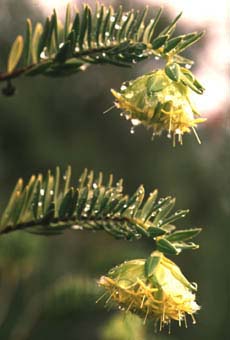 |
The majority of Australian families have VAM associations and many are also known to have VAM from overseas studies. Representatives of some of these families are illustrated below.
|
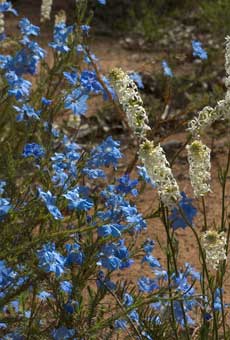 |
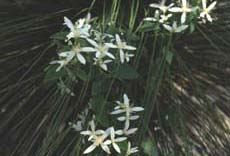
Clematis pubescens |
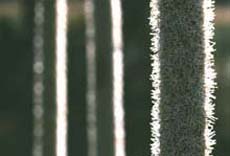
Xanthorrhoea preissii |
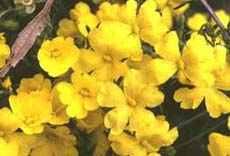
Hibbertia hypericoides |
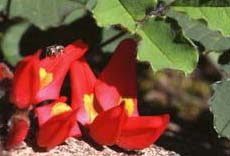
Kennedia prostrata |
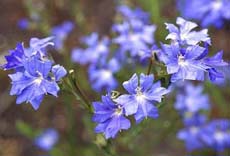
Lechenaultia biloba |
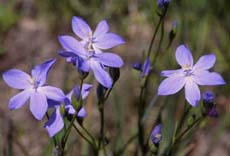
Orthosanthus laxus |
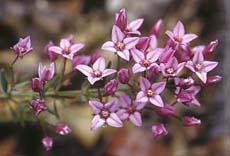
Boronia spathulata |
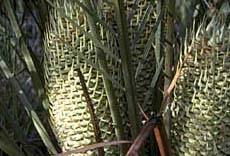
Macrozamia riedlei |
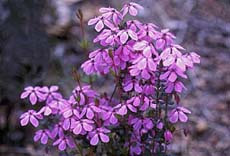
Tetratheca hirsuta |
2. ECM Families
Australian plant families whose members have ECM include the Casuarinaceae, Fabaceae (Mimosoideae, Papiloinoideae), Meliaceae, Myrtaceae, Nothofagaceae, Nyctaginaceae, Phyllanthaceae and Rhamnaceae. These plants usually have dual ECM/VAM associations and, with the exception of Nothofagaceae, these families also include plant genera which only host VAM. Dual associations are much less prevalent in other parts of the word (Brundrett 1991, 2002). Some examples of Australian ECM fungi is presented in Section 9.
In the family Casuarinaceae, the genus Casuarina has been reported to predominantly have VAM while Allocasuarina has ECM and VAM (Koske et al. 1992, Khan 1993, Dell et al. 1994). Members of the Casuarinaceae also have nitrogen fixing nodules and cluster roots (Lamont 1982, Reddell et al. 1986, Thoen et al. 1990, Reddell et al. 1986, 1997).
Several reports of ECM associations of members of the Sterculiaceae (Warcup 1980) need to be reassessed as these plants have beaded roots which are sometimes mistaken for ECM.
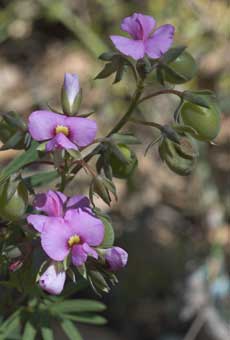
Gompholobium venustum |
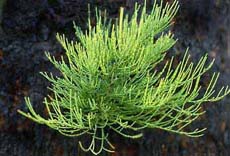
Allocasuarina resprouting after fire - Casuarinaceae |
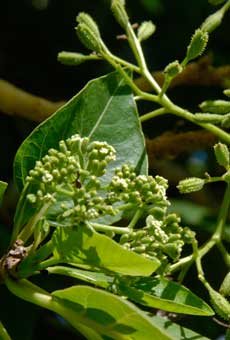
Pisonia grandis (Heron Island) - Nyctaginaceae |
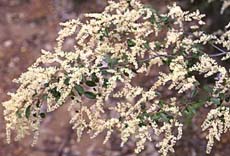
Trymalium floribundum - Rhamnaceae |
I. Myrtaceae
Many trees and larger shrubs in the Myrtaceae in Australia have dual ECM/VAM associations. However, small shrubs in the Myrtaceae, such as Calytrix and Verticordia, only have VAM (Brundrett & Abbott 1992). Apogeotrophic roots of Backhousia, Lophostemon and Syzygium growing within tree bark above ground can also have ECM in Queensland rainforests (Reddell et al. 1996). ECM associations also occur in Eucalyptus gomphocephala root mats within ground water in caves (Jasinka et al. 1996).
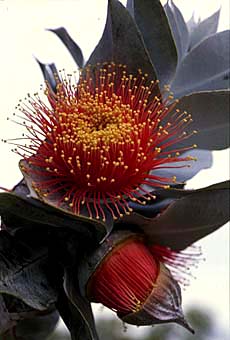 |
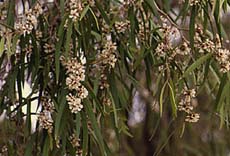 |
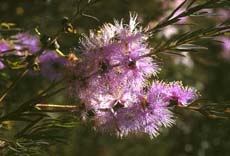 |
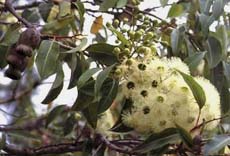 |
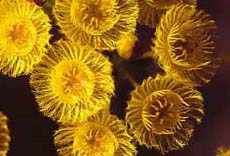 | |
Eucalyptus megacarpa |
Agonis flexuosa ECM / VAM |
Melaleuca radula ECM / VAM Melaleuca |
Corymbia (Eucalyptus) calophylla ECM (VAM) Gum Tree |
Verticordia subulata VAM |
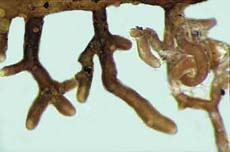
ECM roots of Corymbia calophylla |
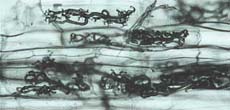
VAM association with arbuscules in root of Corymbia calophylla |
Eucalyptus seedlings in plantations or disturbed sites may initially have VAM associations, which are replaced by ECM associations as they mature (Gardner & Malajczuk 1988, Bellei et al. 1992, Chen et al. 2000, Adams et al. 2006). Even mature eucalypt trees can have VAM with arbuscules next to ECM roots as shown. More examples of Eucalyptus ECM are provided in Section 9. |
II. Fabaceae (Peas)
Australian leguminous plants in the Fabaceae can have VAM, ECM and VAM, NM cluster roots, or VAM and cluster roots (Brundrett & Abbott 1991). Genera reported to have ECM include Chorizema, Gastrolobium, Gompholobium, and Oxylobium. Members of the Fabaceae also have nitrogen fixing nodules (Lamont 1982).
Acacia species may have ECM and VAM, or only VAM. In northern and eastern Australia, Acacia species were reported to have dual VAM and ECM associations or VAM only (Warcup 1980, Reddell & Warren 1987, Bellgard 1991, Brundrett et al. 1994), while acacias from south-western Australia only had VAM (Jasper et al. 1989, Brundrett & Abbott 1991).
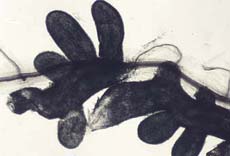 |
Massively swollen ECM roots of Gompholobium venustum a small shrub in the Papilionaceae with ECM and VAM |
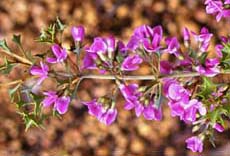 |
Mirbelia dilatata flowers |
III. Atypical (Superficial) ECM Associations
Superficial colonization of long roots, apparently due to ECM fungi, has been observed on roots of some VAM plants. These associations differ from typical ECM associations , because there is a thin mantle, no substantial Hartig net and roots do not respond by slow longitudinal growth, or radial swelling. This has been observed on the roots of Australian plants in the families Apiaceae, Asteraceae, Euphorbiaceae, Goodeniaceae, Lobeliaceae and Stylidiaceae (Warcup 1980, Warcup & McGee 1983, Kope & Warcup 1986, McGee 1986). These associations do not conform to a morphological definition of ECM and may be equivalent to endophytic activity (Section 10).
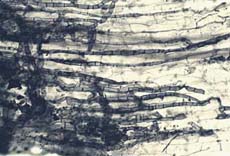 |
Fungus colonisation on the surface of a Scaevola crassifolia root. |
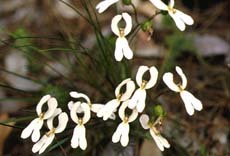 |
Stylidium schoenoides |
3. Orchids
Orchid mycorrhizas were found in all Australian terrestrial orchids examined. These fungi are used to propagate Australian orchids (Batty et al. 2002). Orchid mycorrhizas are briefly described in Section 1.
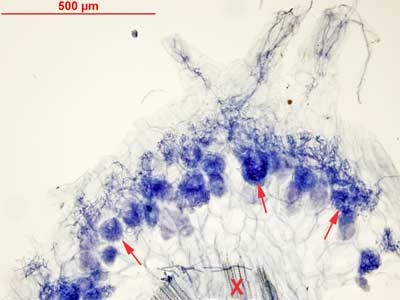 |
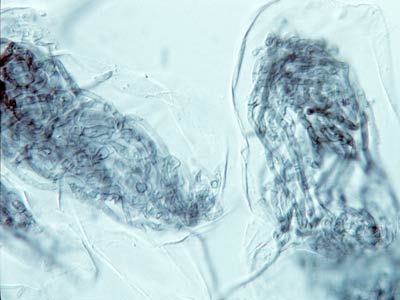 |
Orchid mycorrhiza of Pterostylis sanguinea stem with coils (arrows) hyphae entering rhizome through branched trichomes. |
High magnification of hyphal coils in root cells of Thelymitra crinita. Each hyphal coil (pelotion) is approximately 150 µm long. |
West Australian Terrestrial Orchids
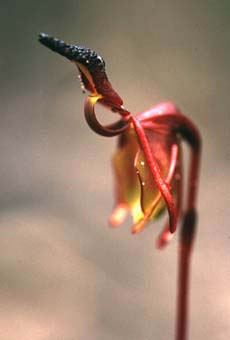
Paracaleana nigrita |
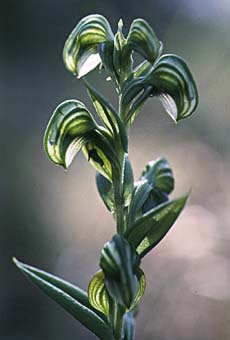
Pterostylis sanguinea |
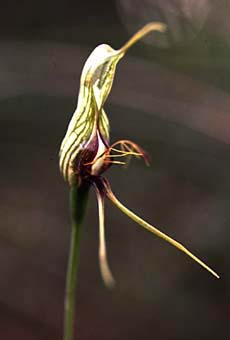
Pterostylis barbata |
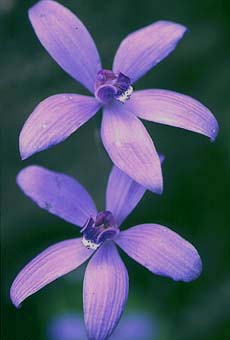
Cyanicula sericea |
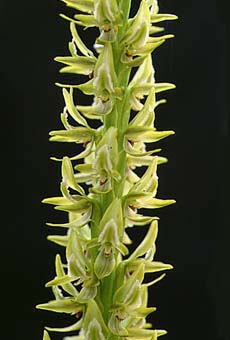
Prasophyllum elatum |
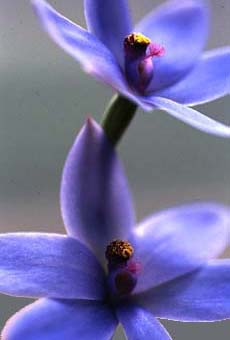
Thelymitra crinita |
4. Ericoid Mycorrhizas
Reed (1987) examined 22 genera and Hutton et al. (1994) examined 14 species. All had ericoid associations. The structure of these associations is very similar to those described from the Northern Hemisphere (Smith & Read 1997, Massicotte et al. 2005b).
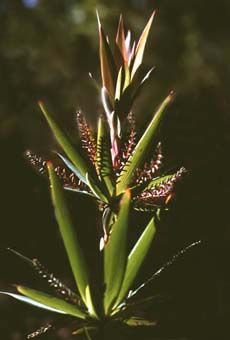
Leucopogon verticillatus |
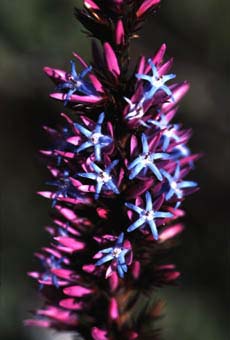
Andersonia caerulea |
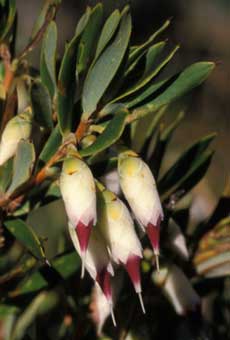
Conostephium pendulum |
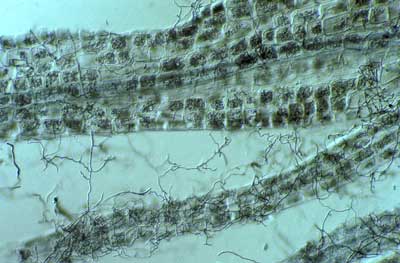 |
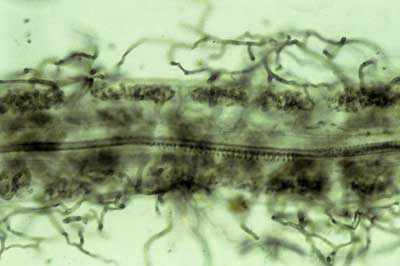 |
Ericoid mycorrhiza in a hair roots and a coarser of Leucopogon verticillatus. |
closer view of mycorrhiza in a hair root of L. verticillatus. |
5. Thysanotus Associations
In roots of Thysanotus species fungal hyphae are restricted to subepidermal cavities in an unusual form of mycorrhizal association first observed by McGee (1988). He found that these associations enhanced the growth of Southern Australian species of Thysanotus. The fungi colonising Thysanotus roots have not been identified.
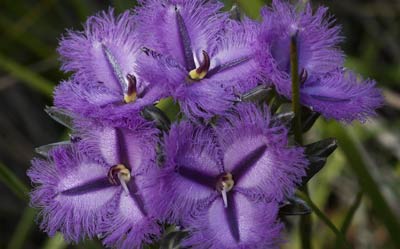 |
 |
Thysanotus triandrus |
Cross section of a Thysanotus root with hyphae in sub-epidermal cavity (arrows). |
6. Conclusions
- As is the case in other regions of the World (Brundrett 1991), VAM is the most prevalent association in Australian plant communities.
- Trees and plants with ECM associations are dominant in many habitats, and nonmycorrhizal (NM) species such as members of the Proteaceae are also relatively common (Lamont 1982, Brundrett & Abbott 1991, Lambers et al. 1996).
- Plants in the families Orchidaceae and Ericaceae have consistent mycorrhizal associations different from those of other plants.
- Most Australian NM plants have root systems with extensive root hairs and/or root clusters (dense aggregations of lateral roots). Plants with cluster roots include most members of the Proteaceae and Kennedia, Daviesia and Viminaria in the Fabaceae.
- Monocotyledons in the Commelinaceae, Cyperaceae, Dasypogonaceae, Juncaceae, Haemodoraceae and Restionaceae have lost mycorrhizas in favour of root clusters and/or sand-binding roots.
- Roots of families such as the Proteaceae, Restionaceae and Cyperaceae are usually remain free of fungi, but apparently can occasionally contain VAM.
- Parasitic and carnivorous plants generally also have NM roots.
- Australian plants with ECM, usually have dual ECM/VAM associations. These include many important trees and shrubs in the families Fabaceae and Myrtaceae. However, there are also many plants in these families that only have VAM.
- Some plants in the Asteraceae, Goodeniaceae and Lobeliaceae with VAM are reported to also have associations which resemble ECM, but these lack a key defining feature (the Hartig net).
- The greatest variety of mycorrhizal strategies occurs within the tribe Mirbelieae in the family Papilionaceae, which includes (i) plants with VAM only, (ii) plants with dual ECM/VAM and (iii) NM plants with cluster roots and (iv) plants with VAM and cluster roots.
- There are even differences in mycorrhizal strategies within some genera. For example, Kennedia has species with VAM (K. prostrata, K. rubicunda) or with NM cluster roots (K. coccinea).
- The complexity of mycorrhizal associations in families much as the Myrtaceae and Fabaceae makes it necessary to sample roots to determine mycorrhizal association types.
The complexities of the root biology of Australian plants are a fascinating topic for study. Evidence that nutrient uptake strategies appear to be evolving more rapidly here, than elsewhere is provided by differences in the mycorrhizal status of plants within families such as the Fabaceae and Myrtaceae, or even within some genera. However, the majority of families have consistent mycorrhizal associations. The versatility of roots of many important Australian trees and shrubs may be an adaptation to survival in harsh or fluctuating environmental conditions. It would seem that no nutrient uptake strategy is clearly superior to the others, as plants with different root types coexist in most plant communities. The functional diversity of the roots of Australian plants may be important to maximise nutrient cycling and conservation and may help to explain the very high plant diversity that occurs in extremely infertile soils.
D. Help Provide Information
This page will be updated to include new information. Please provide any additional relevant information you have or know about. Include complete citation information and your name as you would like it to appear for acknowledgment purposes. It is also necessary to state the criteria you used to designate association types (i.e. Arbuscules for VAM, Hartig net for ECM).
- E-mail information to Mark Brundrett.
Version 2 © Mark Brundrett 2008